
Matias M, Pinteus S, Martins A, Silva J, Alves C, Mouga T, Gaspar H, Pedrosa R.
In recent decades, seaweeds have proven to be an excellent source of bioactive molecules. Presently, the seaweed Gelidium corneum is harvested in a small area of the Portuguese coast exclusively for agar extraction. The aim of this work was to fully disclosure Gelidium corneum as a sustainable source of antimicrobial ingredients for new dermatological formulations, highlighting its potential to be explored in a circular economy context. For this purpose, after a green sequential extraction, these seaweed fractions (F1–F5) were chemically characterized (1H NMR) and evaluated for their antimicrobial potential against Staphylococcus aureus, Staphylococcus epidermidis and Cutibacterium acnes. The most active fractions were also evaluated for their effects on membrane potential, membrane integrity and DNA damage. Fractions F2 and F3 displayed the best results, with IC50 values of 16.1 (7.27–23.02) μg/mL and 51.04 (43.36–59.74) μg/mL against C. acnes, respectively, and 53.29 (48.75–57.91) μg/mL and 102.80 (87.15–122.30) μg/mL against S. epidermidis, respectively. The antimicrobial effects of both fractions seem to be related to membrane hyperpolarization and DNA damage. This dual mechanism of action may provide therapeutic advantages for the treatment of skin dysbiosis-related diseases.



